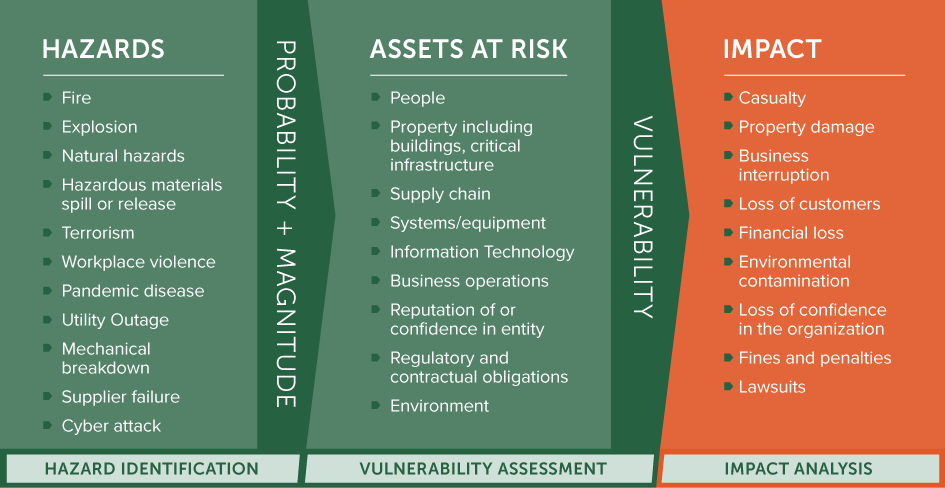School safety is always front and center. According to the Mackinac Center for Public Policy, school safety is among the determining factors for both parents and students switching schools. A recent report from Axios found that 68 percent of “Generation Z” (the post-Millennial generation) say that “school shootings are the most important issue facing the U.S.“
This puts a great deal of pressure on administrators and local officials to find and implement solutions—as cheaply and quickly as possible.
All-Hazards Emergency Planning for Schools
The Department of Homeland Security (DHS) always advises an “all-hazards” approach to security and emergency planning:
“There are many different threats or hazards. The probability that a specific hazard will impact your business is hard to determine. That’s why it’s important to consider many different threats and hazards and the likelihood they will occur.”
DHS offers many handy and easy-to-use resources for businesses performing their all-hazards risk assessment. The U.S. Department of Education’s Readiness and Emergency Management for Schools (REMS) Technical Assistance Center offers very detailed school-specific emergency-planning resources. Unfortunately, while these are quite in depth, they are also a good deal less user-friendly than the Ready.gov materials. If the U.S. Department of Education’s materials seem daunting, start by focusing on these four sections of their site:
- The “At-a-Glance” overview
- “Understand the Situation“
- The list of specific threats and hazards for schools to consider
- The emergency-specific procedures for schools
The 4 Steps To All-Hazards Planning
Step 1: Identify Hazards
Take a comprehensive look at the many hazards that your school faces. This list on the REMs website is an excellent starting point.
It is easy to get focused on items in the news—which tend to be both dramatic and rare. According to the National Safety Council (NSC), opioids, suicide, auto accidents, and accidental falls are the leading causes of preventable death in the United States. Most of us know someone who has died this way. But you almost never see a front-page news story about a specific death from any of these causes. Meanwhile, an active shooter event will get news coverage for days.
In schools, we already know that active shooter incidents are a rarity. But they are stunning tragedies, and so, we plan for them. Bomb threats, fires, child custody issues, and neighborhood disputes are quite common in schools. They warrant serious consideration.
Once you’ve listed your hazards, rate each in terms of probability (how likely it is for your school) and magnitude (how bad it would be).
For example, most schools need to consider fires to be a high probability event with low magnitude (there are thousands of fires in schools every year, but very few result in any injury or fatality). An active shooter event is low probability (only about 0.03% of schools suffer such a tragedy) but extremely high magnitude.
Step 2: Consider Your Assets
Obviously, first and foremost, the greatest assets to any school are the students, staff, and community members.
But these are not the sole assets. When engaging in an all-hazards planning process, your asset list should include both physical assets (buildings, equipment, etc.) and non-tangible assets (reputation, community confidence, peace-of-mind for staff and students, etc). For a school, it is usually the case that these less tangible assets are extremely valuable and easily damaged.
Finally, identify each asset’s vulnerabilities. What makes that asset likely to fall prey to one of the hazards you listed in Step #1? Is that asset likely to be directly targeted, or will it be damaged as a side effect?
A vulnerability will always do at least one of the following:
- increase the probability of an event
- increase the magnitude of an event
Step 3: Assess Impacts
Go through your list of hazards (from Step #1), and consider the potential impact on each asset (identified in Step #2).
When possible, pin down the monetary costs associated with the damage or loss of each asset. This calculation may seem heartless—especially when it comes to human lives—but it is important. There is always going to be some stage in your hazard reduction program when costs need to be justified to someone. You need to be ready to show what’s at stake, both emotionally and economically.

Step 4: Weigh Possible Mitigations
A mitigation seeks to reduce the impact a hazard/vulnerability has on your assets. A mitigation might do this at any stage:
- It can eliminate a hazard/vulnerability
- It can reduce the probability of an event
- It can lessen the magnitude of the event
- It can ease the impact of an event
- It can speed recovery
Some mitigation strategies will reduce risks at multiple stages or for multiple distinct hazards.
For example, increasing the physical security of your building’s entrance and funneling visitors through a secured vestibule will slow or stop an active shooter. It will also deter or complicate a planned family abduction, and even address more benign issues, like students cutting classes. Adding a nurse, psychologist, or other para-professional won’t just reduce the probability of a violent altercation at the school, but can also mitigate the lingering impact of an unforeseen traumatic event (such as a violent storm or national emergency).
Considering All Hazards When Planning for School Safety
Total Security Solutions CEO Jim Richards has decades of experience in creating physical security and access control for public buildings—including many, many schools. As Jim explains:
“TSS has, for a long time, strongly advocated for an ‘all-hazards’ approach in general. And this is even more so in schools. It’s really easy to get distracted by the really terrible things we see in the news. But there are so many schools, with so many students, that this is a situation where you really have to play it by the numbers, and balance both your fear of the magnitude of one threat with the statistical certainty of another. Take a comprehensive look at your challenges. We’ll provide the physical components to mitigate those threats.”



